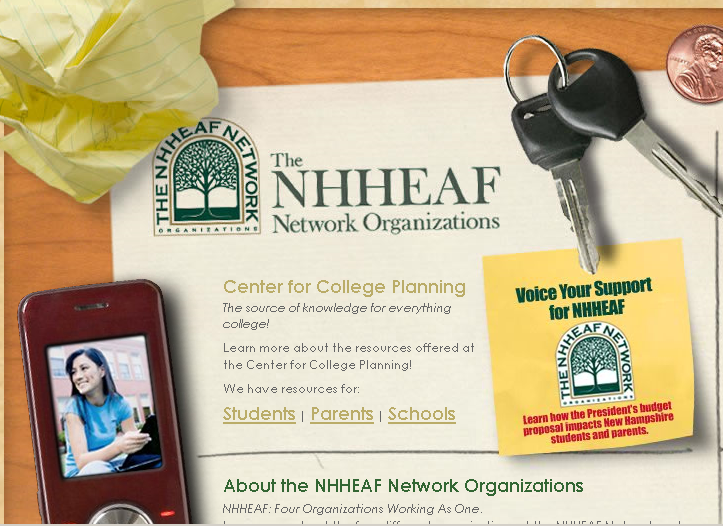Student Loan Changes – Just What Exactly Is Congress Proposing?
The recent enactment of H.R.3221 The Student Aid and Fiscal Responsibility Act of 2009 by Congress has many students wondering what impact the new changes will have on them and their student loans.
According to the Seattle Times, “Congress’ overhaul of the college student-loan system offers welcome relief to students at risk of drowning in debt.”
But, while many are applauding the proposed changes, others are taking a more skeptical view. Today we offer readers a Q & A with Tara Payne of the New Hampshire Higher Education Assistance Foundation. Ms. Payne currently serves as the Vice President of Corporate Communications for the NHHEAF Network Organizations.
 The New Hampshire Higher Education Assistance Foundation (NHHEAF) was established in 1962 to guarantee student loans. Since 1965, it has been the designated guarantor for the Federal Family Education Loan Program (FFELP) in New Hampshire.
The New Hampshire Higher Education Assistance Foundation (NHHEAF) was established in 1962 to guarantee student loans. Since 1965, it has been the designated guarantor for the Federal Family Education Loan Program (FFELP) in New Hampshire.
As one major function, NHHEAF is responsible for the initial application, disbursement of funds, default prevention, default collections, and oversight of the federal loan programs. For fiscal year 2008, NHHEAF guaranteed over $213 million in federal loans and the agency continues to rank among guarantors recording the nation’s lowest default rates.
Yet under the proposed legislation, NHHEAF, one of those so-called ‘middlemen’ in the loan process, might no longer exist. Such a scenario led us to the agency to try and gather additional perspective on the legislation.
We were fortunate to have the opportunity to pose a number of very specific questions to a person with more than a decade of experience at the organization. Ms. Payne offers a wealth of perspective having helped construct the organization’s Center for College Planning department. Today, that department reaches almost 30,000 New Hampshire students and parents each year, offering free college planning, financial literacy and financial aid expertise via presentations, materials and websites.
Can you explain in brief terms exactly what Congress is debating and the rationale for the debate? What is meant by the phrase, the new loan process will “cut out the middle man?”
The President’s budget proposal includes the elimination of the Federal Family Education Loan Program (FFELP). As a FFELP provider, the NHHEAF Network Organizations (NHHEAF) is involved in funding, originating, disbursing and servicing student loans for New Hampshire students from our New Hampshire office. The Presidents budget eliminates the local role in the student loan process. The government’s language about “middlemen” implies that agencies like ours are a “cog in the wheel”, not a major source of community support for families, schools and citizens of our state.
New Hampshire’s program is managed by a nonprofit FFELP provider. This means that proceeds from the loan program are reinvested in our community. We reinvest into strong financial literacy programs, early college awareness and financial aid preparation for students and their families at K-12 schools.
We employ 200 New Hampshire residents who are truly dedicated to supporting student loan borrowers. Our success is evident in NHHEAF having among the lowest default rates in the nation. When these local services go away, students suffer.
Our focus is on increasing aspirations, providing funding and best-in-class service. No government program can replace this local resource. As a school counselor who utilizes our programs shared recently, “NHHEAF is the best thing to happen to higher education since I started teaching in 1974.”
In what ways would students and parents be positively impacted by this legislation? Are there any potential negatives?
The legislation includes several positive aspects including increased Pell Grant funding for the lowest income students and increased funding and support for community colleges. Supporting New Hampshire’s low income students is essential to our mission. We fully support any effort to provide additional funding to the neediest students.
However, under current legislation, FFELP would be eliminated and yet Pell would still not be an entitlement. “Eliminating subsidies to lenders” is a politically-charged cry for support. The public hears this and reacts with unbridled support … assuming that those subsidies will go into making the program less expensive for them.
As Bill Spiers, the Financial Aid Director of Tallahassee Community College described, “While the media has focused on the profitability in the FFELP program, little has been said about the fact that the federal government must fund Federal Pell Grant Program increases off the backs of student borrowers.
The government borrows money at very low rates, much lower than those available to lenders, yet the government would continue to charge the same interest rates as FFEL lenders. Under the current proposal the “federal government isn’t providing any breaks to the students and is actually making more off the program than lenders ever could”
While most student borrowers pay a fixed 6.8% interest rate on federal student loans and parent borrowers 8.5%, lenders in the FFELP are required to pay back the difference between what borrowers pay and today’s lower market yield to the federal government.
The difference between the cost of funds and the borrower rate of interest is even greater in the Direct Loan program, so much that the proposed record increase in Pell Grants would be largely funded from the interest rate spread the Department of Education will enjoy from student and parent borrowers paying a far higher rate of interest on their federal education loans than the federal government is paying on its borrowing costs. Enacted legislation required that loans made on or after July 1, 2006 carry a higher fixed rate for students and parents that is not market driven. Had interest rates remained variable, Stafford loans today would have been an extremely favorable 1.88% (in school and grace) interest rate (2.48% repayment rate), and PLUS loans would be at 3.28% in the current low interest rate environment.
Will these changes have any impact on the FAFSA application process?
 The CEO of our agency, Mr. Rene Drouin, actually sits on the Federal Advisory Committee for Financial Assistance and has been an advocate for these changes which simplify the financial aid process for students. By reducing the number of questions and simplifying the FAFSA form, families may not be as intimidated. Still, while shortening the form may help for those already committed to going to college, it will not increase college aspirations.
The CEO of our agency, Mr. Rene Drouin, actually sits on the Federal Advisory Committee for Financial Assistance and has been an advocate for these changes which simplify the financial aid process for students. By reducing the number of questions and simplifying the FAFSA form, families may not be as intimidated. Still, while shortening the form may help for those already committed to going to college, it will not increase college aspirations.
When our staff visits schools in communities like Colebrook and Nashua and Portsmouth and Keene, we offer consistent support which encourages education beyond high school and personalized assistance filing the forms and understanding the award letters for free. Ninety-three percent of New Hampshire high schools invite our full-time college counselors to their schools to educate their students and families throughout the academic year.
Which types of loans will be impacted: Stafford, Plus Loans, Consolidated Loans?
All federal student loans.
How will the legislation impact colleges and universities?
It is important to note that the Direct Loan program has been around since the Clinton administration. To offer some perspective on the use of Direct Loans in New Hampshire, consider that in fiscal year 2008, FFELP loan volume was at $409 million for 89,000 borrowers. Federal Direct Loan volume was only $13 million for fewer than 3,000 borrowers.
Nationally, 70% of post-secondary schools chose to work with FFELP because of the strong technological, programmatic and financial literacy programs it offers. Now, they will have no choice. And, they will have no local support.
Right now, NHHEAF has a full-time staff which provides a hotline, technical support and regular visits to schools for financial literacy activities for their students. NHHEAF also has a strong Compliance Department which ensures that schools have local support for any regulatory or student-eligibility questions that might arise. Both departments also provide in person training and webinars on a range of professional topics.
Supporting the financial aid professionals goes hand-in-hand with supporting the student borrowers on their campuses. Further, the proposal assumes that the government can effectively and efficiently run a program this large. It is estimated that 4,400 schools will be forced to convert from FFELP, their program of choice, to the Direct Loan program on July 1, 2010.
The U.S. Department of Education will be tasked with converting an average of nearly 500 schools a month over the course of a nine month period. Since the Direct Loan program’s inception in 1993, roughly 1,600 schools have been converted over a 16 year timeframe. For schools currently in the FFEL program, this would mean investing staff, time and money to change systems and processes at a time where budgets have been cut to the core. It’s realistic to imagine that those costs may have to be absorbed through increased tuition and student fees.
 Will anyone theoretically be hurt by these changes? If private banks lose this source of revenue, what negative impact might it have on their role as lending institutions within the community?
Will anyone theoretically be hurt by these changes? If private banks lose this source of revenue, what negative impact might it have on their role as lending institutions within the community?
Minimally, 40,000 jobs are at stake across the nation. For agencies like ours, student loans are the only source of revenue. It would be devastating. And, the impact on the local economies would be brutal. Consider that in NH alone, NHHEAF spent $6.8 million on local vendors and contributed $5.1 million in charitable spending. Multiply that by all of the agencies like ours across the country and it is severe. And, again, at the end of the day, will most college-bound families experience any significant savings? It is unlikely.
The amount that could be saved by the Federal Government is projected to be in the billions of dollars – based on the current legislation as proposed what is the plan for this money? Will it be used to attack the current federal deficit or will the funds be rolled into further funding support for students?
The Office of Management and Budget (OMB) indicates that, under the President’s budget proposals, which include the switch to 100-percent Direct Lending, debt held in the Government’s various Direct Loan accounts is expected to rise from $632 billion in FY 2009 to $1.58 Trillion in FY 2019, an increase of more than $900 billion. Nationalizing the education loan programs will add substantially to the national debt over the next decade and the beneficiaries of student loans will have to pay interest twice: first, the interest they’ll owe on their loan as a student borrower and second on the interest they’ll owe as a taxpayer via the national debt.
Corporations exist to earn and distribute business earnings to shareholders, while nonprofit agencies like NHHEAF exist to provide programs and services that are of public benefit. Often these programs and services are not otherwise provided by local, state, or federal entities. Particularly in a state with low levels of state aid, high public tuition costs and high debt burdens, promotion of college opportunities, financial aid and affordability is even more critical in order to get students to think realistically about higher education.
Can you briefly explain why the legislation is seen so differently by Republicans (opposed to these changes) and Democrats (support for the changes)?
I couldn’t speculate on this except to offer that many legislators want to support the President’s budget proposal for its supposed savings while many others doubt the savings purported will materialize. Originally, the Congressional Budget Office (CBO) estimated that savings from the President’s proposal would total $94 billion.
In June, the costs savings were estimated at $87 billion. Senator Judd Gregg urged CBO to recalculate its projection to incorporate market risk cost. The CBO then revealed that the proposal to replace new guaranteed loans with direct loans would lead to estimated savings of about $47 billion over the 2010–2019 period. Most recently, the OMB predicted that the savings from the proposed transition to 100-percent Direct Lending will be $41.4 billion over the same time period. And, many legislators question the role of government in taking over a public-private program that has supported students and schools successfully for decades.
Still, it is important to note that some do see that there is a role for nonprofits in the student loan process. In fact, Representative Carol Shea-Porter (D-NH) worked tirelessly to ensure that nonprofit student loan servicers would not be shut out of future Government contracts. Note that Under the Sense of Congress from the FY10 Concurrent Budget Resolution, sec. 605, it reads, “any reform of the federal student loan programs to ensure that students have reliable and efficient access to federal loans should include some future role for the currently involved private and non-profit entities, including state non-profits with 100% FFEL lending in the State, and capitalize on the current infrastructure provided by private and non-profit entities, in order both to provide employment to many Americans during this time of economic distress and to maintain valuable services that make post-secondary education more accessible and attainable for many Americans; and therefore, pursuant to any changes to the student loan programs, loan processing, administration, and servicing should continue to be performed, as needed, by for-profit and non-profit entities.”



November 9th, 2009 at 9:26 am
Journalism is dead in this country, it really is! Negative press sells advertising. Follow the money my friends….ask yourself why does this article want me to hate UoP? Why do they want me to feel bad for people who signed their names to countless documents but refuse to take responsibility? Why is making a profit a bad thing in this country? This country was founded on capitalism, right? Why do journalists want to demonize money? This article for all it’s supposed “investigation” is slanted to the left, the far left. Where is the balance? Where are the interviews from hundreds of thousands of students that have graduated from the University of Phoenix? Why don’t we ever hear about average people and their issues why is it we only stand up and take notice when the story centers on a “poor minority”? As though everyone else has to own up to their responsibility but if you are a poor minority you don’t. Am I to believe there is a “Financial Aid fairy” that comes to the minorities and the poor and pays for all their education? Why don’t we as a collective group realize and agree that bad people exist but they come in all shapes, colors & social economic backgrounds and you don’t necessarily to be educated. Let’s teach our children, “trust but verify” or “show me”. If we as a collective group just decided to follow the money and ask a couple of questions like what is the agenda of this writer? Why does this reporter want me to believe in him? Who is this group and what makes them the authority on this subject?
What is NPR’s agenda? Do you know NPR main funding is from the federal government? Do you know President Obama and his administration hates private anything, especially if it makes money? Did you know the current administration is trying to eliminate the FFELP student loan program? The FFELP program gives the student a choice in what lender they want to have service their student loan based on their comfort zone. What will happen to the employees that currently work in the private banks, will their jobs be eliminated? If the government gets their way they are going to convert all the FFELP student loans to Direct Loan; no more choice and higher interest rates.
Bottom line, NPR stands for the National Public Radio, partners with PBS, Public Broadcasting Service, i.e. the government, follow the money. Who stands to profit if for “profit schools” get bad press? Did you know that the generous billionaires Herb & Marion Sandler are the funders of ProPublica publications? Did you know Herb and Marion sold their World Savings for $4 million in 1963 and building it into mighty Golden West Financial Corp., one of the largest home mortgage lenders in the country? In 2006, they lost Golden West, which had over $125 billion in assets, to Wachovia for $24 billion. Wachovia, which made the terrible decision to purchase the company’s portfolio of subprime loans, teetered on the edge of bankruptcy when the housing market collapsed. It reported losing $24 billion in the third quarter of 2008 and was ubsequently acquired by Wells Fargo at the end of 2008 for a paltry $12.7 billion. Makes ya go HMmmmmmmm. Did you know early this year, the couple found their way onto Time magazine’s list of 25 People to Blame for the Financial Crisis.” Golden West had been a pioneer in the creation of exotic mortgage products such as the option adjustable-rate mortgages, known as ARMs. (Chumley 2009) Personally, before NPR or ProPublica throws mud I think they better clean up their own house.